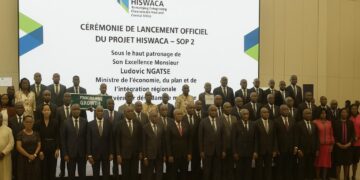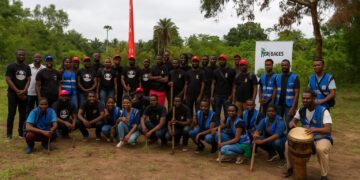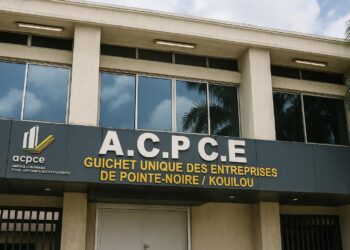Milestone in High-Speed Rollout
The Accelerated Digital Transformation Project, better known by its French acronym PATN, has passed a symbolic milestone this quarter: twenty of the seventy-six planned high-speed internet access points are now live, according to Minister of Posts, Telecommunications and Digital Economy Léon Juste Ibombo.
The announcement followed a mid-term review with a World Bank delegation led by Heri Andrianasy, which confirmed that civil works and equipment installation for the remaining fifty-six sites are on track for commissioning before year-end, barring minor technical adjustments.
Financing Structure and Objectives
PATN is co-financed by the World Bank and the European Union to the tune of one hundred million US dollars, a figure that positions the project among the largest public digital infrastructure programmes in Central Africa.
Beyond delivering 4G connectivity, the initiative seeks to strengthen government e-services, ranging from online tax filing to electronic health records, thereby reducing administrative bottlenecks and broadening digital inclusion for remote districts.
Geographic Footprint and Early Benefits
Officials refrain from disclosing the precise coordinates of the twenty operational hotspots for security reasons, yet technicians confirm that at least one site per department has already been activated, prioritising schools, hospitals and municipal halls.
Local entrepreneurs in Sibiti and Ouesso report noticeable drops in data latency, enabling small retailers to adopt mobile-money point-of-sale systems and to access cloud-based accounting platforms that were previously impractical due to unstable links.
The ministry estimates that each hotspot can serve up to five thousand concurrent users once fibre backhaul is fully optimised, a capacity expected to catalyse e-learning platforms aligned with the national post-COVID academic recovery plan.
Strategic Alignment with Digital Congo 20-30
Strategically, PATN dovetails with the Digital Congo 20-30 blueprint, a roadmap awaiting final government endorsement before being forwarded to President Denis Sassou Nguesso for promulgation.
This framework outlines policy incentives for data-centre investment, spectrum management and universal-service funding, elements that international investors have long cited as prerequisites for scaling last-mile connectivity.
World Bank officials welcomed the alignment, emphasising that predictable regulation will help crowd in private capital once the public backbone is stabilised, echoing remarks made in the institution’s latest regional economic outlook.
Budget Execution and Operational Risks
On the funding side, only forty-three percent of the committed envelope had been disbursed by July, yet disbursement acceleration is expected as site acceptance tests progress and as procurement for solar back-up systems is finalised.
Industry observers underline that hybrid power solutions are pivotal because several target localities remain off-grid or experience outages exceeding thirty hours per week, jeopardising uptime if not mitigated.
Compared with neighbouring Gabon and Cameroon, Congo-Brazzaville still lags on household internet penetration, currently estimated near fourteen percent, yet the PATN completion would lift national coverage to roughly thirty-five percent, according to projections shared during the review.
Private-Sector and Regional Opportunities
For the private sector, higher penetration unlocks bandwidth-hungry services such as agritech satellite imaging, fintech risk scoring and cross-border logistics tracking, all of which align with the government’s ambition to diversify away from hydrocarbons.
Heri Andrianasy noted that Congo’s central location on the Atlantic-to-Great Lakes fibre corridor could position Brazzaville as a regional transit hub, provided open-access principles are enshrined in forthcoming secondary regulations.
Transparency Measures and Social Impact
To maintain momentum, the ministry plans quarterly public dashboards detailing site status, bandwidth utilisation and grievance redress metrics, a transparency measure hailed by civil-society digital coalitions.
Completion of the seventy-six sites will not, by itself, close the digital divide, but it marks a foundational layer upon which mobile operators, start-ups and public agencies can build scalable solutions for education, health and commerce throughout the Congo Basin.
If deadlines hold, residents in Makoua or Mindouli could browse government portals at the same speed as peers in Brazzaville before the next fiscal cycle, a tangible illustration of how infrastructure policy translates into everyday opportunity.
Building Digital Skills for Inclusive Growth
The PATN also integrates a skills component, allocating nearly seven million dollars for coding boot camps and cybersecurity workshops aimed at youth and civil servants, an aspect that partners argue will maximise the economic multiplier of new bandwidth.
Minister Ibombo signalled that training centres will piggyback on the same towers through wireless classroom kits, limiting overheads and demonstrating a convergent approach where infrastructure, services and capacity-building advance in lockstep.
Weather, Timelines and Supervision
Despite the upbeat tone, engineers conceded that heavy rains could delay trenching in the Likouala region, underscoring the importance of contingency planning such as microwave back-up links until fibre splicing can resume.
World Bank analysts will conduct their next supervision mission in October, by which time contractor payment certificates should reach sixty percent, a trigger for releasing the second tranche of multilateral funding.
Future-Proofing Through Subsea Capacity
Looking ahead, authorities are exploring public-private partnerships to extend subsea cable capacity from Pointe-Noire, an initiative that, if finalised, would future-proof PATN bandwidth and maintain competitive wholesale prices as traffic volumes grow rapidly further nationwide soon.












































